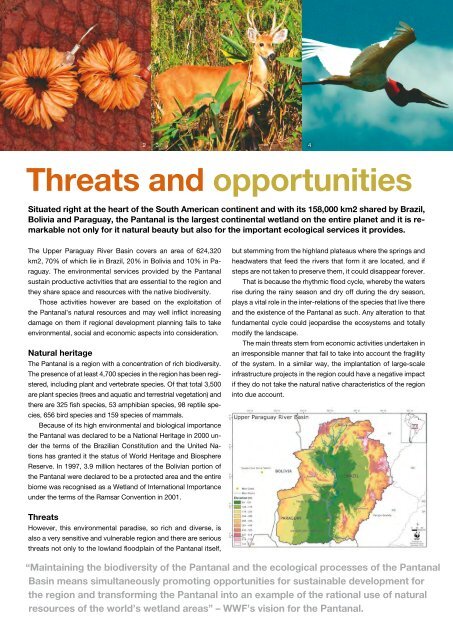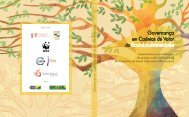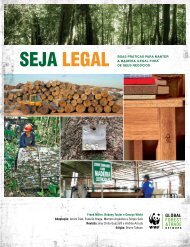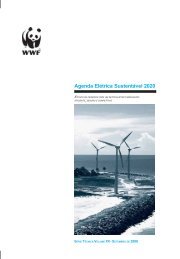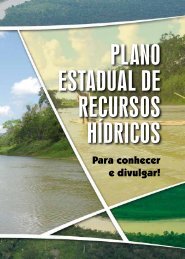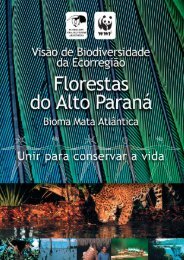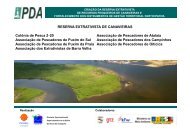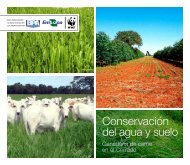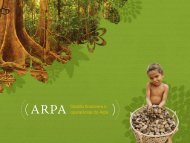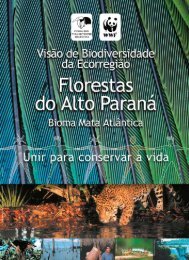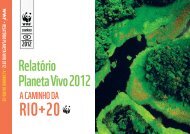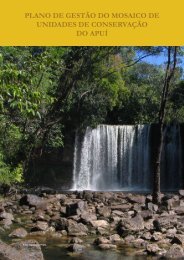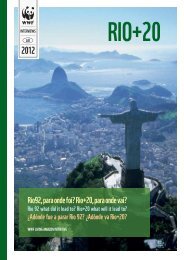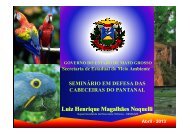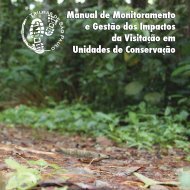Unifying Waters
Unifying Waters
Unifying Waters
You also want an ePaper? Increase the reach of your titles
YUMPU automatically turns print PDFs into web optimized ePapers that Google loves.
2 3 4<br />
Threats and opportunities<br />
Situated right at the heart of the South American continent and with its 158,000 km2 shared by Brazil,<br />
Bolivia and Paraguay, the Pantanal is the largest continental wetland on the entire planet and it is remarkable<br />
not only for it natural beauty but also for the important ecological services it provides.<br />
The Upper Paraguay River Basin covers an area of 624,320<br />
km2, 70% of which lie in Brazil, 20% in Bolivia and 10% in Paraguay.<br />
The environmental services provided by the Pantanal<br />
sustain productive activities that are essential to the region and<br />
they share space and resources with the native biodiversity.<br />
Those activities however are based on the exploitation of<br />
the Pantanal’s natural resources and may well inflict increasing<br />
damage on them if regional development planning fails to take<br />
environmental, social and economic aspects into consideration.<br />
Natural heritage<br />
The Pantanal is a region with a concentration of rich biodiversity.<br />
The presence of at least 4,700 species in the region has been registered,<br />
including plant and vertebrate species. Of that total 3,500<br />
are plant species (trees and aquatic and terrestrial vegetation) and<br />
there are 325 fish species, 53 amphibian species, 98 reptile species,<br />
656 bird species and 159 species of mammals.<br />
Because of its high environmental and biological importance<br />
the Pantanal was declared to be a National Heritage in 2000 under<br />
the terms of the Brazilian Constitution and the United Nations<br />
has granted it the status of World Heritage and Biosphere<br />
Reserve. In 1997, 3.9 million hectares of the Bolivian portion of<br />
the Pantanal were declared to be a protected area and the entire<br />
biome was recognised as a Wetland of International Importance<br />
under the terms of the Ramsar Convention in 2001.<br />
but stemming from the highland plateaus where the springs and<br />
headwaters that feed the rivers that form it are located, and if<br />
steps are not taken to preserve them, it could disappear forever.<br />
That is because the rhythmic flood cycle, whereby the waters<br />
rise during the rainy season and dry off during the dry season,<br />
plays a vital role in the inter-relations of the species that live there<br />
and the existence of the Pantanal as such. Any alteration to that<br />
fundamental cycle could jeopardise the ecosystems and totally<br />
modify the landscape.<br />
The main threats stem from economic activities undertaken in<br />
an irresponsible manner that fail to take into account the fragility<br />
of the system. In a similar way, the implantation of large-scale<br />
infrastructure projects in the region could have a negative impact<br />
if they do not take the natural native characteristics of the region<br />
into due account.<br />
Threats<br />
However, this environmental paradise, so rich and diverse, is<br />
also a very sensitive and vulnerable region and there are serious<br />
threats not only to the lowland floodplain of the Pantanal itself,<br />
Nonsequidi auda conecea sitibusam nemos ius<br />
“Maintaining the biodiversity of the Pantanal and the ecological processes of the Pantanal<br />
Basin means simultaneously promoting opportunities for sustainable development for<br />
the region and transforming the Pantanal into an example of the rational use of natural<br />
resources of the world’s wetland areas” – WWF’s vision for the Pantanal.


